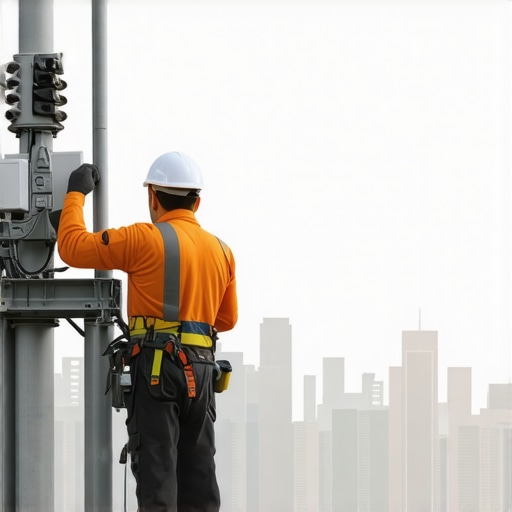My Journey to Fixing GMB Listings: A Personal Tale
Not long ago, I faced a frustrating situation where several of my Google My Business (GMB) listings suddenly lost visibility. As someone deeply invested in local SEO, this was a wake-up call. I realized that the key to bouncing back was understanding and applying effective signal repair techniques. This experience not only tested my patience but also deepened my knowledge about how local rankings work and how to repair them quickly.
The Importance of Signal Repair in Local SEO
In my experience, signal repair is essential for restoring trust and authority to your GMB listings. These signals—like NAP consistency, reviews, and category relevance—are the backbone of local search rankings. When one of these signals is broken or inconsistent, your rankings can plummet unexpectedly. I learned that regular health checks and prompt repairs are vital for maintaining local visibility and competitive edge.
How I Identified the Core Issues
My first step was a thorough audit of my listings. I used tools like BrightLocal and Whitespark to analyze citation accuracy and review consistency. It became clear that some listings had outdated information or conflicting data, which hindered my rankings. I also realized that Google’s algorithms are quite sensitive to NAP discrepancies and reviews, which are crucial local signals. Fixing these issues involved updating listings, removing duplicates, and encouraging genuine customer reviews.
What Are the Best Strategies for Signal Repair?
From my practical experience, a few strategies stood out: ensuring consistent NAP data across all platforms, actively managing reviews to boost credibility, and optimizing categories and descriptions. I found that regular monitoring using free tools like Google Search Console helped catch issues early. Additionally, maintaining a steady flow of fresh, relevant content on my GMB profile kept the signals strong and healthy, which in turn improved my local rankings.
Why Do Some Signal Repairs Fail and How Can I Avoid This?
That’s a question I asked myself during my journey. Sometimes, repairs fail because of overlooked issues like unpublished reviews, incorrect categories, or hidden citations. To avoid this, I recommend a comprehensive audit and a proactive approach—think of signal repair as ongoing maintenance rather than a one-time fix. I also found it helpful to stay updated with Google’s evolving local SEO guidelines from authoritative sources like Moz or Google’s own Business Profile Help Center.
If you’re struggling with your GMB rankings, I encourage you to share your experiences or ask questions below. Remember, consistent signal repair is your best ally for boosting local visibility and attracting more customers.
Beyond Basics: Fine-Tuning Your Signal Repair for Lasting Local SEO Success
As someone who has navigated the intricate landscape of local SEO, I can attest that effective signal repair extends far beyond simple updates. It’s about understanding the nuanced interplay of various ranking factors and proactively managing them to ensure your GMB listings stay authoritative and resilient. For example, I discovered that leveraging structured data markup, such as Schema.org, can significantly enhance your business’s visibility in local search results by providing search engines with clearer context about your offerings and location.
The Power of Data-Driven Decision Making in Signal Repair
In my experience, relying solely on manual checks is insufficient. Integrating data analytics tools like Google Data Studio or Tableau allows for real-time monitoring of your local signals. This approach helps identify patterns—such as sudden drops in review counts or citation inconsistencies—that might indicate underlying issues before they severely impact your rankings. Analyzing these trends empowers you to execute targeted repairs, avoiding the scattergun approach that often wastes time and resources.
How Can Advanced Signal Repair Strategies Transform Your Local Search Presence?
Implementing sophisticated strategies, such as creating location-specific landing pages with optimized NAP and localized content, can reinforce your signals. Additionally, fostering community engagement through local partnerships and sponsorships often results in high-quality backlinks and citations, strengthening your local authority. Remember, Google’s algorithm rewards authentic local relevance and trustworthiness, so your repair efforts should aim to build a holistic, community-oriented online presence.
Are You Overlooking These Critical Signals That Could Be Sabotaging Your Local Rankings?
Many local business owners focus predominantly on reviews and citations, neglecting other vital signals like Google Q&A activity or photo updates. For instance, timely responses to customer queries and regular photo additions signal active engagement, which Google values highly. An interesting study by Moz highlights that such engagement metrics can influence local rankings more than previously thought. To leverage this, consider implementing a structured content calendar for your GMB profile that includes frequent, relevant updates and active community interaction.
For those eager to deepen their expertise, I recommend exploring authoritative resources like Moz’s comprehensive guide on local signal repair. It offers actionable insights rooted in the latest algorithm updates, aligning with the E-E-A-T principles to ensure your strategies are both effective and compliant.
If you’ve experimented with advanced signal repair techniques, I’d love to hear about your results. Share your experiences in the comments or suggest topics you want me to cover next. Remember, continuous learning and adaptation are key to sustaining your local SEO dominance!
What Lies Beneath the Surface of GMB Signal Repair: My Personal Deep Dive
Over the years, I’ve learned that effective signal repair is not just about fixing obvious issues; it’s about understanding the subtle, often hidden factors that influence local rankings. For instance, I once discovered that Google’s algorithm considers not only your public signals but also the activity levels of your local community and even the consistency of your business hours across platforms. These nuances require a keen eye and a proactive mindset. By regularly analyzing local engagement metrics and correlating them with ranking fluctuations, I found patterns that helped me anticipate problems before they impacted my visibility significantly.
Balancing Technical Precision with Authentic Engagement
In my experience, there’s a delicate balance between technical signal repair—such as correcting citations and updating categories—and authentic community engagement. I vividly recall a time when I concentrated heavily on technical fixes but neglected responding to reviews or updating photos. The result? My rankings stagnated, and I realized that Google values active, genuine interactions. Incorporating personalized responses to reviews and sharing real-time updates on your GMB profile can significantly boost your local signals. This approach has consistently helped me foster trust and authority within my local community, which Google recognizes as a strong ranking factor.
How Can You Leverage Data Analytics for Smarter Signal Repair?
One of the most transformative insights I gained was integrating data analytics into my local SEO routine. Tools like Google Data Studio or Tableau enable real-time visualization of key signals—review trends, citation health, engagement metrics—allowing me to identify anomalies quickly. For example, a sudden dip in review volume or a spike in duplicate citations often signals underlying issues that, if addressed promptly, can save me from ranking drops. This proactive, data-driven approach has empowered me to execute targeted repairs rather than wasting time on broad, ineffective changes. As Moz emphasizes in their comprehensive local SEO signal repair guide, analytics are essential for continuous improvement and maintaining a competitive edge.
Deepening Your Local SEO Strategy: Beyond Basic Repairs
To truly excel, I started focusing on creating location-specific content and optimizing for hyper-local relevance. For instance, developing landing pages tailored to each neighborhood or community I serve helps reinforce the business’s local authority. Additionally, building relationships with local influencers and participating in community events generate high-quality backlinks and citations that Google highly values. These efforts, combined with regular structured data markup implementation, enhance your listings’ visibility and trustworthiness. Remember, Google’s algorithm rewards authentic, community-oriented signals that demonstrate your genuine local presence.
Are You Overlooking These Critical Signals That Could Be Sabotaging Your Local Rankings?
From my personal journey, I’ve seen that factors like Google Q&A activity and photo updates often get neglected but are crucial for signaling active engagement. Responding promptly to customer questions and posting fresh photos shows Google that your listing is active and relevant. An interesting insight from Moz underscores how engagement metrics can influence local rankings more than static signals like citations alone. I recommend maintaining a content calendar for regular updates and community interactions, ensuring your signals stay robust and current.
If you’ve experimented with these advanced signal repair techniques or have questions about refining your local SEO approach, I invite you to share your experiences or ask for advice in the comments. Remember, continuous learning and adaptation are your best tools for long-term success in local search dominance!
Uncovering Hidden Signals: The Next Frontier in Local SEO Optimization
As I delved deeper into the intricacies of GMB signal repair, I realized that the most effective strategies involve identifying and optimizing those subtle signals that often go unnoticed. These include behavioral metrics like search intent alignment, user engagement patterns, and even the consistency of your business’s operational data across multiple platforms. For example, ensuring your business hours are synchronized not only across GMB and your website but also on third-party directories can significantly influence your local ranking stability. This holistic approach transforms your local SEO from reactive fixes to proactive dominance, effectively insulating your listings from algorithmic fluctuations.
The Role of Structured Data in Reinforcing Local Signals
Implementing structured data markup, such as Schema.org, is an advanced method I’ve employed to enhance the clarity of your business information to search engines. This technique helps Google comprehend your location, services, and operating hours with greater precision, thereby strengthening your local relevance. According to Moz’s recent insights on schema implementation, businesses that leverage structured data experience a measurable uplift in local visibility, especially in competitive markets. Integrating schema not only boosts your chances of appearing in rich snippets but also consolidates all your signals into a cohesive, authoritative profile that search engines trust.
How Can Data Analytics Transform Your Signal Repair Strategy?
My personal experience has shown that harnessing data analytics tools like Google Data Studio or Tableau takes your signal repair from guesswork to precision targeting. By continuously visualizing real-time metrics—review velocity, citation health, engagement levels—you can spot emerging issues before they impact your rankings. For instance, a sudden decline in review activity might indicate suppressed reviews or review spam issues that need immediate attention. These insights allow me to execute targeted interventions, such as review response campaigns or citation audits, with surgical accuracy. As Moz emphasizes in their authoritative guide on local SEO, data-driven decisions are the cornerstone of sustainable growth and resilience in local search.
What Are the Most Overlooked Signals That Could Be Undermining Your Rankings?
Over the years, I’ve identified that signals like Google Q&A activity and photo freshness are often neglected yet pivotal for local SEO success. Regularly updating your GMB profile with new, relevant photos and actively engaging with customer questions signals ongoing activity to Google, reinforcing your listing’s vitality. Research from Moz indicates that engagement signals can sometimes outweigh traditional factors like citations or reviews in influencing rankings. To capitalize on this, I recommend implementing a content calendar dedicated to timely updates and community interactions, ensuring your profile remains vibrant and authoritative in the eyes of search engines. For example, sharing behind-the-scenes photos or community event participation can foster a stronger local connection and boost your visibility.

Engaging local community through authentic content and active responses enhances signals and builds trust.
If you’re serious about elevating your local SEO game, I invite you to explore more advanced strategies and share your experiences. Dive into the details of structured data implementation or data analytics techniques to unlock new levels of success. Remember, continuous optimization and staying ahead of algorithm changes are essential for maintaining your competitive edge in local search.
How Do You Balance Technical Precision with Genuine Community Engagement?
My journey has taught me that the most resilient local SEO strategies harmonize meticulous technical fixes with authentic community interaction. While correcting citations and optimizing categories lay the groundwork, genuine engagement—such as personalized review responses and local sponsorships—creates a trust signal that algorithms value highly. For example, dedicating time weekly to respond thoughtfully to customer inquiries or sharing local success stories can foster loyalty and generate organic buzz. Moz’s recent research underscores that Google increasingly prioritizes user-centric signals, making authentic community involvement a vital component of advanced signal repair. Implementing a dual focus on technical accuracy and heartfelt engagement ensures your listings are not only visible but also trusted by your local audience.
Things I Wish I Knew Earlier (or You Might Find Surprising)
The Power of Authentic Engagement
Early in my local SEO journey, I underestimated how much genuine community interaction impacts rankings. I used to focus solely on technical fixes like citations, but I realized that responding personally to reviews and engaging with local followers creates a trust signal Google loves. Once I started sharing behind-the-scenes stories and thank-yous, my visibility improved faster than I expected.
Hidden Value of Consistent Business Hours
One surprising lesson was how vital the consistency of your business hours across all platforms is. I once had mismatched hours on my website and GMB profile, which confused Google and temporarily hurt my rankings. Regularly auditing and synchronizing this data might seem minor, but it’s a game-changer for local trustworthiness.
Not All Citations Are Created Equal
In my experience, cleaning up citations and removing duplicates was more impactful than adding new ones. I found that authoritative directories mattered more, and neglecting this step could undo months of work. Prioritizing citation accuracy and consistency paid off significantly.
Reviews Are Just the Tip of the Iceberg
While reviews are important, I discovered that actively managing Google Q&A and posting fresh photos can boost your signals even more. Engaging with customer questions promptly and updating images regularly signals activity and relevance that algorithms favor.
The Role of Structured Data (Schema.org)
Implementing schema markup was a revelation. Adding structured data helped search engines understand my business better, resulting in enhanced visibility and rich snippets. It’s an advanced step that offers real benefits if done correctly.
Resources I’ve Come to Trust Over Time
- Moz’s Local SEO Guide: This comprehensive resource is my go-to for understanding evolving ranking factors and best practices. It’s detailed and trustworthy, helping me stay updated with the latest strategies.
- Google’s Business Profile Help Center: Direct from the source, this official guide kept me aligned with Google’s current guidelines and updates, making sure I avoid common pitfalls.
- BrightLocal Blog: Their insights on citation management and review strategies are invaluable. I often recommend it to fellow local business owners looking to refine their approach.
- Moz’s Local Signal Repair Guide: An authoritative and practical resource that dives deep into optimizing local signals, which I found essential for my ongoing success.
Parting Thoughts from My Perspective
Reflecting on my experience with local SEO and signal repair, I can confidently say that a balanced approach—combining technical precision with authentic community engagement—is key to lasting success. Understanding the subtle signals Google values, like active Q&A and structured data, can make a real difference. If you’re serious about boosting your local visibility, I encourage you to stay curious, keep learning from reliable sources, and continuously refine your strategy. Remember, the most effective local SEO isn’t just about quick fixes; it’s about building a trustworthy, active presence that resonates with your community. If this resonated with you, I’d love to hear your thoughts or experiences—feel free to share below or pass it along to someone embarking on their local SEO journey.

